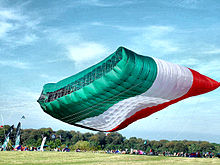Peter Lynn
Peter Lynn (* 1946 ) is a New Zealand kite builder . He owns the largest kite in the world and is the inventor of the kite buggy .
Life
In 1973, Lynn and his wife Elwyn opened a kite shop near Ashburton , New Zealand, where they produced kites for children. In 1974 Peter Lynn developed the triangular box kite, a kite made up of many triangular cells. In early 1984 he then developed large rodless kites such as the centipede, the manta, the octopus, the puffer fish, the gecko and the trilobite.
In 1987 he started designing power kites for boats, buggies and snow sleds. The buggy in its original form was actually designed to drive on the water (the concept is available as a kitecat). It wasn't until 1990 that Lynn converted it into a country buggy by replacing the skis with wheels. More than 10,000 of his buggies are now in use. There are now many other dragon buggy manufacturers - buggy driving has become a popular sport around the world. In 2005 Peter Lynn developed the KiteSled, which is also pulled by kites. In May 2006 the Australians Patrick Spiers and Ben Diakon made a 700 kilometer Greenland trip with KiteSleds. With the KiteSleds they were about 20% faster than on skis.
In 1994 Peter Lynn invented the "Super ripstop" ram air kite construction system for large and towing kites. In 1995 he designed the Mega Ray. The Mega Ray is a rodless, ray-like dragon. This nine-colored giant consists of 635 m² spinnaker nylon and is approx. 42 m long. He can apply a pulling force of 2000 kg. The concept was recognized by the Guinness Book of Records in 1997 as the largest kite in the world.
In 1997 he developed the first “hybrid” towing kite, which is fundamentally suitable for all kite sports . The Peter Lynn Arc combines advantages and shape of the at Kitesurfen used Tubekites (variability of the tensile force, relaunch from the water surface after a crash) and a Foilkite (z. B. better glide through smoother profile). The concept, which Lynn's son Pete Lynn is constantly developing, has great potential. An arc is less prone to gusts of wind, is easy to control and uses a self-stabilizing profile. This enables the pilot to leave the sail unattended in the wind without any steering impulses. The kite is then stable in the zenith of the wind window . These features make a Peter Lynn Arc ideal for beginners to land kiting or kite surfing. While the concept is widespread in Australia and New Zealand , it has relatively few followers in Europe. This is mainly due to marketing strategies.
Most of the year Lynn travels the world with his kites and attends international kite festivals with his kites.
Web links
| personal data | |
|---|---|
| SURNAME | Lynn, Peter |
| BRIEF DESCRIPTION | New Zealand kite maker |
| DATE OF BIRTH | 1946 |
